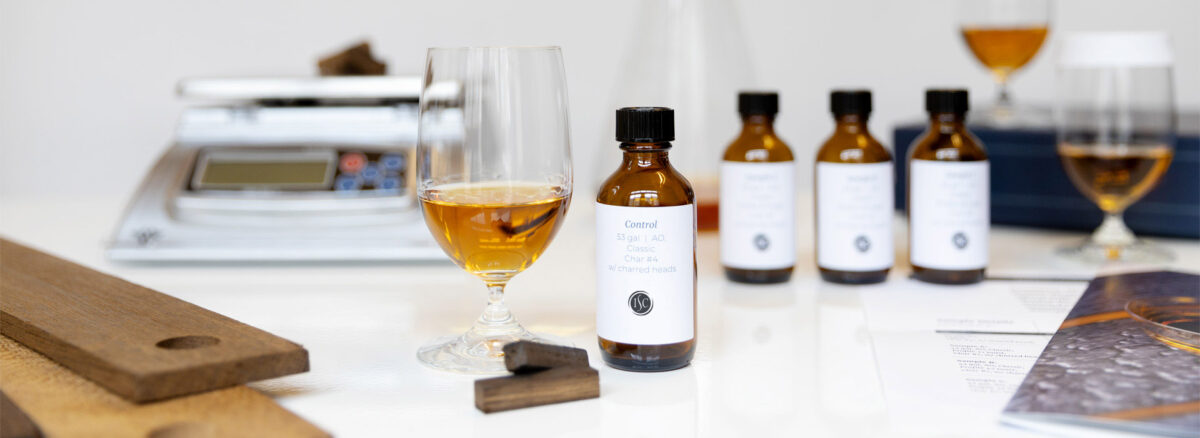The Lifecycle of an Experiment
At Independent Stave Company, we feel it is necessary to be on the forefront of barrel innovation. We try our best to deliver new and innovative barrels for our distilling partners on a near constant basis. The process of developing a new type of barrel takes quite a bit of time. Before we release a new type or offer a new variation on an existing barrel, we will test the idea in what we call a commercial barrel experiment. In a commercial barrel experiment, we provide a set of barrels to a partnering distillery, and they fill and age them in their warehouses for a set period of time. Each year, they give us samples from the barrels to conduct both sensory and chemical analysis. An experiment usually lasts about four years. However, some of our experiments are scheduled to last upwards of ten years.
Four years (or more) is a long time to wait in order to determine if a new barrel design idea is valid and is something that will be useful to distillers. It is similar to having a really exciting idea and then having to wait four years to tell your friends. By then, you do not really know if the idea is still going to be relevant or if the idea even worked for that matter. We have had experiments go both ways…sometimes you wait four years, and the results are exactly what you want to see. Other times, you wait four years, and the experiment fails. What you thought would happen, doesn’t. What you thought might be the next great barrel idea, isn’t. We go through a lot of this in the research department at ISC.
With the end of 2022 rapidly approaching, I thought I would tell you about a few of the experiments that came to a close this year. Remember, if you have any questions about the results, don’t hesitate to reach out to us via the contact form.
Toast Profile Experiment
- Initiated – 2016
- Number of Barrels – 60
- Location – Kentucky
The purpose of this experiment was to learn more about how different toast profiles and toasting temperatures brought upon different flavors during the maturation period. I have tasted this whiskey more times than I can count over the past six years. What a wonderful and informative experiment this was. The knowledge gained from this experiment resulted in the creation of several new barrels that can now be found in our Small Batch Collection. This could be one of the most important experiments we have completed.
Oak Species Experiment
- Initiated – 2018
- Number of Barrels – 24
- Location – Kentucky
This is a repeat study of an experiment we initiated back in 2013. Often, we will repeat experiments if we run low on samples or if we want to see how the variations behave under different circumstances. In this case, it was both. We had a pretty good idea of how different oak species affected the flavor development of barrel aged spirits but this time we wanted to bring the experiment to the Kentucky climate and do this with a typical bourbon whiskey mash bill.
Smoked Barrel Finishing
- Initiated – 2020
- Number of Barrels – 24
- Location – Texas
This was a very cool experiment. The idea was to smoke our new barrels with different types of hardwood material to see if the essence of the smoke could be transferred to the whiskey that gets filled into the barrels. The experiment worked beautifully. We had lots of questions when the idea was first conceived. It took about a year’s worth of lab work before we officially launched this concept and then we spent another two years with the actual commercial barrel experiment. Our new line of Small Batch Smoked Barrels was born from this experiment. We are continuing to innovate on this line of barrels so stay tuned to our blog for more information as it becomes available.
Moonshine University Experiment
- Initiated - 2017
- Number of Barrels – 30
- Location – Kentucky
Years ago, I partnered with Colin Blake, Director of Education at Moonshine University in Louisville Kentucky to create a new class that we hoped would give new distillers a jumpstart on learning about flavor development in barrel aged spirits. Not only would we teach the students about all the variables involved in making barrel aged spirits, but we would also let the students taste how these variables altered the final product. In order to do that, we started this barrel experiment in which we tested variables such as char level, toast level, wood species, entry proof, mash bill, distillation proof, etc. As we would teach the students about the effects of changing the entry proof for example, we would bring out three different whiskeys from the barrel experiment. All of which were aged in the same barrel with the only difference being the entry proof at which they entered the barrel. The class has been a tremendous success and is still going on to this day. Check out the Moonshine University website for more information.
At the conclusion of each experiment, I always feel that the time went by faster than I expected. I get a little sad to see them go. However, success or failure, each experiment teaches us something new and we put that knowledge to good use in future experiments.
CHEERS,
Andrew


Comments 1
I would be interested to hear more about the oak species experiment(s). My understanding is that almost all barrels are made of either the American white oak (Quercus alba) or one of two European species (Q. robur or Q. petraea). The U.S. has several oak species in the white oak (Leucobalanus) section of the genus that ought to be at least physically suitable for barrelmaking – bur oak, swamp white oak, chestnut oak, overcup oak, to name a few in the East, Oregon white and Valley oak out West (Q. macrocarpa, bicolor, montana, lyrata; garryana and lobata), but I’ve never heard of any of them being used even though some of them are very widespread and reach large sizes that could certainly produce good staves. The wood of white oak section species is all very similar in basic anatomy and characteristics like strength, flexibility, etc., but whether they differ in the taste they impart to spirits, I’d be interested to know.